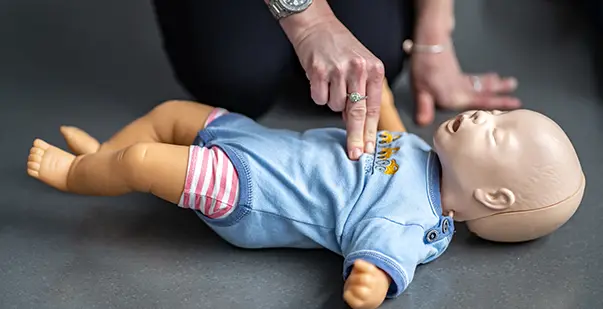Pediatric cardiac emergencies are rare but critical. Therefore, you must know the correct pediatric CPR ratio to save their life. Every year, as per AHA, approximately 7,000 children experience out-of-hospital cardiac arrest in the United States alone. However, only 8.4% of pediatric patients survive to discharge. The sobering statistic underpins the importance of CPR. However, it is important to recognize that CPR is not a one-size-fits-all approach. Performing CPR on adults differs from infants or children. Read on to learn how the pediatric CPR ratio differs from adult ones, so that you can provide appropriate care for them in emergencies.
Read More: CPR for Adults vs. Children: Key Differences
Why Does Pediatric CPR Rate Differ from Adult CPR Ratio?
The pediatric CPR ratio differs from adults, due to the difference in their anatomy, which affects how CPR is performed. When you recognize these differences, you can tailor your CPR approach for each group. The distinct features include,
Smaller Airway Size: Children and infants have smaller airways, which makes them more prone to blockages and choking episodes.
Delicate Rib Cage: The bones in children are more flexible and can be easily broken/damaged if you apply too much pressure.
Faster Metabolism: Unlike adults, children and infants burn/utilize oxygen more rapidly due to their higher metabolic rates. It means they need quicker interventions.
Cause of Cardiac Arrest: In adults, the cause of cardiac arrest is usually due to heart-related issues. However, in children, it occurs due to respiratory problems like choking or drowning.
What Is the Correct CPR Ratio for Children and Infants

With an understanding of the precise pediatric CPR ratio, you can confidently save a life during emergencies. Current American Red Cross guidelines establish specific compression-to-ventilation ratios based on the number of rescuers present and the child's age. These evidence-based recommendations optimize blood circulation while ensuring adequate oxygenation for pediatric patients. Let’s take a brief look at them:
Standard Infant CPR Ratio
The correct infant CPR ratio depends on your rescue scenario. For single rescuers, perform 30 chest compressions followed by 2 rescue breaths (30:2). This ratio applies to all children under 8 years old, including infants under 12 months. When two trained rescuers work together, the infant CPR ratio changes to 15:2. This modification allows for more frequent ventilation while one rescuer focuses solely on compressions. Studies in the Journal of Emergency Medicine show that two-rescuer CPR improves outcomes significantly compared to single-rescuer efforts.
Specifications for Child CPR Compression Ratio
Children aged 1-8 years follow the same ratios as infants but require different techniques. The child CPR compression ratio remains 30:2 for single rescuers and 15:2 for two rescuers. However, compression depth increases to approximately 2 inches compared to 1.5 inches for infants. Studies in NIH involving over 15,000 pediatric cardiac arrests show improved survival rates when proper ratios are maintained.
Read More: The 10 Benefits of CPR Certification for Construction Workers
How to Perform CPR on Infants and Children?
Proper technique execution requires understanding anatomical differences between infants and children. Your hand positioning, compression force, and breathing methods must adapt to each age group's unique physiology. Follow these step-by-step guidelines to ensure you deliver effective CPR while maintaining the correct pediatric CPR ratio:
Hand Positioning and Compression Technique
According to the American Red Cross, for infants under 12 months, place two fingers on the breastbone just below the nipple line. Press straight down approximately 1.5 inches using only your fingertips at a rate of 100 to 120 compressions per minute. Allow complete chest recoil between compressions without lifting your fingers from the chest.
Children aged 1-8 years require different hand placements. Use the heel of one hand for smaller children or both hands for larger ones. Position hands on the lower half of the breastbone, compressing 2 inches deep. Keep your arms straight and shoulders directly over your hands.
Rescue Breathing
Infant rescue breathing covers both the nose and the mouth simultaneously. Create a seal over the baby's nose and mouth with your mouth. Deliver gentle puffs of air, watching for visible chest rise with each breath.
For children, perform mouth-to-mouth breathing only. Tilt the head back slightly, lift the chin, and pinch the nose closed. Deliver breaths that make the chest rise visibly but avoid overinflation.
Compression Rate and Cycle Management
Maintain 100-120 compressions per minute for both age groups. Count aloud to keep a consistent rhythm throughout your rescue efforts. After 30 compressions, deliver 2 rescue breaths quickly, then immediately resume compressions, maintaining the infant CPR ratio.
Switch rescuers every 2 minutes to prevent fatigue and maintain compression quality. Continue cycles until emergency medical services arrive or the child shows signs of recovery.
Read More: How to Renew CPR Certification?
Quick Reference: Infant vs. Children CPR Ratios
CPR Component | Infants (Under 1 year) | Children (1-8 years) |
Single Rescuer Ratio | 30:2 | 30:2 |
Two Rescuer Ratio | 15:2 | 15:2 |
Compression Depth | 1.5 inches (4 cm) | 2 inches (5 cm) |
Hand Position | Two fingers below the nipple line | Heel of one or both hands |
Compression Rate | 100-120 per minute | 100-120 per minute |
Ventilation Technique | Mouth-to-mouth and nose | Mouth-to-mouth only |
Chest Recoil | Complete between compressions | Complete between compressions |
What Happens if the Pediatric CPR Ratio is Incorrect During CPR?
Getting the pediatric CPR ratio wrong during an emergency creates serious complications. These mistakes directly impact survival outcomes and can cause additional harm. Here are some consequences you might encounter in such scenarios,
Inadequate Blood Flow
When you perform too few compressions relative to breaths, you compromise circulation. Incorrect ratios mean less blood reaches vital organs like the brain and heart. Only 1–4% of cardiac arrest survivors have good neurological outcomes. The infant CPR ratio of 30:2 maximizes blood flow while ensuring sufficient ventilation.
Insufficient Oxygen
Inadequate ventilation leads to hypoxemia, which indicates dangerously low blood oxygen levels. Children have higher metabolic rates than adults, requiring more oxygen per kilogram. The correct pediatric CPR ratio ensures optimal oxygen delivery during critical moments.
Overventilation
Excessive ventilation creates dangerous complications. Too many breaths increase intrathoracic pressure, reducing blood return to the heart. The recommended respiratory rate is 20-30 breaths per minute for children with advanced airways. The pediatric CPR ratio balances these competing needs through evidence-based recommendations.
How to Know if You Are Delivering the Correct Pediatric CPR Ratio?
In the heat of an emergency, you may often doubt your ability to perform CPR correctly on children and infants. Am I pushing hard enough? Are my breaths too strong? Your hands shake, your heart races, but you must stay focused. The child's life depends on your ability to recognize whether you are delivering the correct pediatric CPR ratio. Here are some signs that ensure you are delivering the right ratio:
Visual Chest Rise During Ventilations
Watch for visible chest rise with each rescue breath you deliver. The chest should lift gently but noticeably during ventilation phases. Excessive chest rise indicates overventilation, while minimal movement suggests inadequate air delivery. Proper ventilation creates smooth, consistent chest movement that returns to baseline between breaths.
Adequate Compression Depth Feedback
Feel for proper compression depth through tactile feedback during chest compressions. Infant compressions should reach approximately 1.5 inches deep using two fingers. Child compressions require about 2 inches of depth using one or both hands. The chest should recoil completely between compressions, allowing full cardiac filling.
Maintaining Consistent Rhythm and Count
Count aloud to maintain the correct pediatric CPR ratio timing. Your compressions should occur at 100-120 per minute consistently. Use the "one-and-two-and" counting method to maintain a steady rhythm throughout cycles. Consistent timing ensures optimal blood flow and prevents fatigue-related technique deterioration.
Recognition of Circulation Signs
Monitor for signs of returning circulation during CPR efforts. Look for color changes, spontaneous movement, or pulse return during brief assessment periods. These signs may indicate effective CPR delivery and potential return of spontaneous circulation. Continue CPR until advanced medical help arrives or clear signs of recovery appear.
Read More: CPR Best Practices for Physicians and Nursing Staff
How Training Helps You Learn the Correct Pediatric CPR Ratio?
A professional CPR program transforms theoretical knowledge into practical life-saving skills. Quality instruction ensures you master the correct pediatric CPR ratio through systematic learning approaches. Here’s how training programs build your confidence for real emergencies.
Hands-On Practice with Manikins
Quality training programs provide extensive practice with age-appropriate manikins. You learn physical differences between infant, child, and adult CPR through hands-on experience. Professional instructors correct common mistakes before they become habits.
Scenario-Based Learning
Modern CPR courses incorporate realistic emergency scenarios. You practice responding to choking incidents, drowning situations, and sudden cardiac events. Enhanced training methods contribute significantly to these improved outcomes.
Learning the Science Behind Ratios
Training explains why specific ratios exist, not just how to perform them. You learn about cardiac output, oxygen consumption, and cerebral perfusion pressure. Understanding these statistics motivates proper technique adherence.
Regular Skills Assessment and Updates
CPR certification courses include skills testing to ensure competency. You demonstrate proper ratios under time pressure, simulating real emergency conditions. Regular recertification keeps skills sharp and knowledge current with the most effective pediatric CPR ratio techniques.
Ready to Respond: Get Certified in Pediatric CPR
The statistics in the Resuscitation Journal speak clearly: improved CPR techniques have increased pediatric survival rates up to 19% in infants. Remember that the infant CPR ratio and child CPR compression ratio serve specific physiological purposes, maintaining blood flow while ensuring adequate oxygenation. Incorrect ratios lead to complications that significantly reduce survival chances. Getting proper training transforms your theoretical knowledge into life-saving skills.
Don't wait until an emergency strikes to learn these critical skills. Enroll in a certified pediatric CPR course today and gain the confidence to respond effectively when a child's life hangs in the balance.
References












